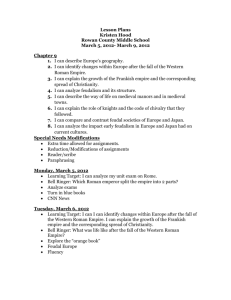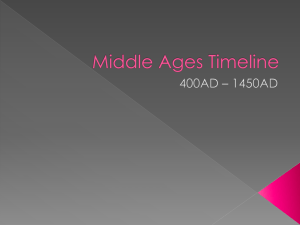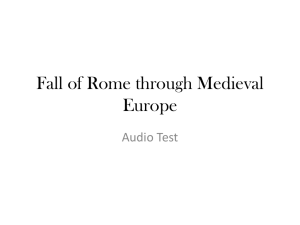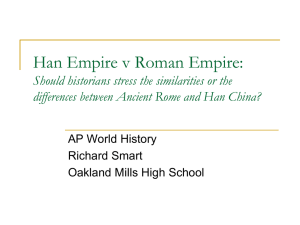Seventh Grade Social Studies Learning Map How was the Roman
advertisement
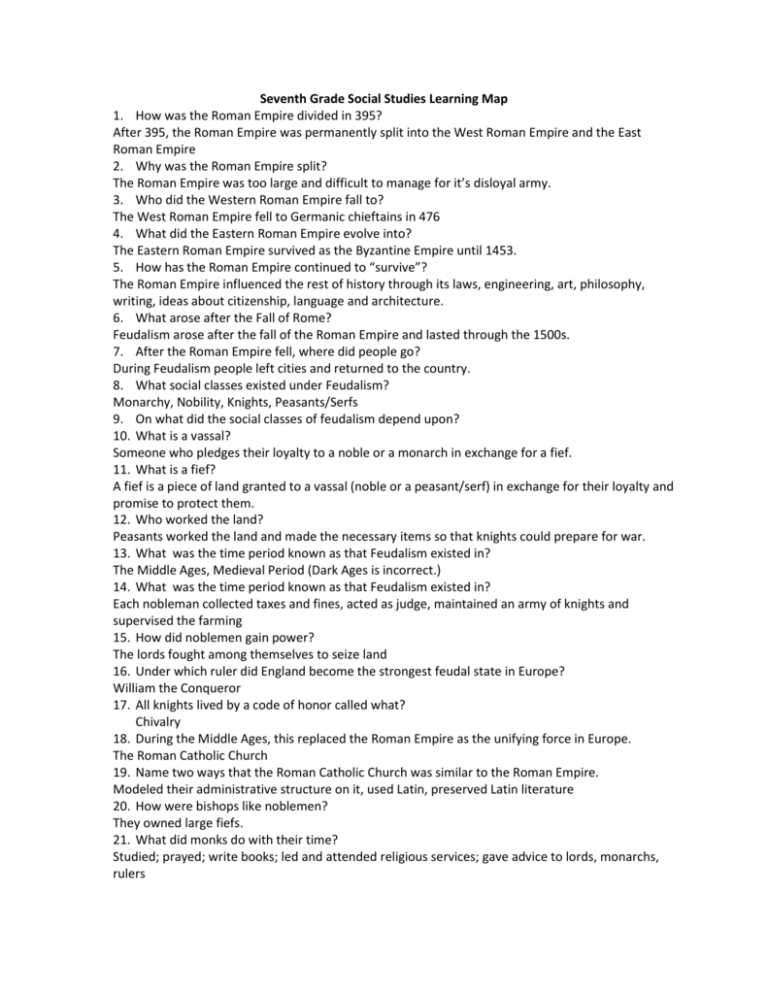
Seventh Grade Social Studies Learning Map 1. How was the Roman Empire divided in 395? After 395, the Roman Empire was permanently split into the West Roman Empire and the East Roman Empire 2. Why was the Roman Empire split? The Roman Empire was too large and difficult to manage for it’s disloyal army. 3. Who did the Western Roman Empire fall to? The West Roman Empire fell to Germanic chieftains in 476 4. What did the Eastern Roman Empire evolve into? The Eastern Roman Empire survived as the Byzantine Empire until 1453. 5. How has the Roman Empire continued to “survive”? The Roman Empire influenced the rest of history through its laws, engineering, art, philosophy, writing, ideas about citizenship, language and architecture. 6. What arose after the Fall of Rome? Feudalism arose after the fall of the Roman Empire and lasted through the 1500s. 7. After the Roman Empire fell, where did people go? During Feudalism people left cities and returned to the country. 8. What social classes existed under Feudalism? Monarchy, Nobility, Knights, Peasants/Serfs 9. On what did the social classes of feudalism depend upon? 10. What is a vassal? Someone who pledges their loyalty to a noble or a monarch in exchange for a fief. 11. What is a fief? A fief is a piece of land granted to a vassal (noble or a peasant/serf) in exchange for their loyalty and promise to protect them. 12. Who worked the land? Peasants worked the land and made the necessary items so that knights could prepare for war. 13. What was the time period known as that Feudalism existed in? The Middle Ages, Medieval Period (Dark Ages is incorrect.) 14. What was the time period known as that Feudalism existed in? Each nobleman collected taxes and fines, acted as judge, maintained an army of knights and supervised the farming 15. How did noblemen gain power? The lords fought among themselves to seize land 16. Under which ruler did England become the strongest feudal state in Europe? William the Conqueror 17. All knights lived by a code of honor called what? Chivalry 18. During the Middle Ages, this replaced the Roman Empire as the unifying force in Europe. The Roman Catholic Church 19. Name two ways that the Roman Catholic Church was similar to the Roman Empire. Modeled their administrative structure on it, used Latin, preserved Latin literature 20. How were bishops like noblemen? They owned large fiefs. 21. What did monks do with their time? Studied; prayed; write books; led and attended religious services; gave advice to lords, monarchs, rulers 22. Who was the largest landholder in Western Europe during the Middle Ages? The Roman Catholic Church 23. What was it called when you kicked a person out of the Church and forbade a person to receive sacraments from the Church? Excommunicate 24. What is an interdict? Closed all churches on a lord’s land so that no one could be married or buried with the Church’s blessing. 25. What are the seven Church sacraments? Baptism, Eucharist, Confession, Confirmation, Marriage, Holy Orders, Extreme Unction (Last Rites) 26. What were the Crusades fought for? To recapture the Holy Land from Muslims. Sign of faith. 27. What is a pilgrimage? Pilgrimages were journeys Christians went on to see sacred religious sites. 28. In the early Middle Ages most people lived in the countryside; when did towns start to grow again? Around 1200 C.E. 29. How did farmers help the growth of towns? Farmers came to town to sell their surplus crops which revived trade and brought merchants to town as well. 30. Where were early towns located? Often outside of castle walls, near water and at the crossroads of common trading routes. 31. Why did disease spread so quickly in the High Middle Ages? Exposed garbage, rubbish, human waste in streets, lack of hygiene 32. What is a guild? A group that protected its members against unfair business practices, established prices and wages, and settled disputes between workers and employers. 33. When did feudalism decline? The decline of feudalism occurred with the growth of trade and industry, the rise of towns, and the Crusades, the Hundred Years War and the increasing strength of the monarchy. 34. What did education and the arts focus on during the High Middle Ages? Learning and the arts during the High Middle Ages were devoted to glorifying God and strengthening the power of the church 35. Why were learning and the arts focused on the Catholic Church? The Church was really the only group to have the money/power to afford such luxuries. Monarchs and nobility who could afford it, wanted to ensure their path to heaven. 36. What did contact with the Arab and Byzantine civilizations do to improve Europe? It brought back much learning and progress and increased interaction between Europe and the Muslim world. 37. Where were universities started? Cathedrals 38. When did the Hundred Years War happen? 1337-1453 39. Who fought in the Hundred Years War? England and France 40. What killed ¼ of Europe’s population in 1347 – 1352? The Black Death / Bubonic Plague / The Plague 41. What did kings do in return for taxes? Provide relative peace and security and a strong central government. 42. What was it called when Martin Luther and other people rebelled against the Catholic Church? The Protestant Reformation 43. What was Humanism? Humanism was when scholars and artists were less concerned with religious thinking, and concentrated more on understanding people and the world. 44. Why are Mecca and Medina considered holy according to Muslims? Revelations to the Prophet Mohammad from Allah through the angel Gabriel took place in the cities of Mecca and Medina. Jerusalem is also a holy city to Muslims because according to faith, it is where Mohammad left the earth from the Dome of the Rock. 45. What is the holy book in Islam? The Quran. 46. What is the oldest monotheistic religion that is still being commonly practiced today? Judaism. 47. What are the two major holy books in Judaism? The Torah and the Talmud. 48. Christianity started as a sect of what religion? Judaism 49. Whose life and teachings is Christianity based upon? Jesus of Nazareth. 50. What is the Holy Trinity? The Christian belief that in one God there are three Persons--the Father, the Son, and the Holy Spirit. 51. What holy book do Christians use? The Old Testament (Jewish Torah) and the New Testament 52. Whose teachings are Buddhism based upon? Siddhartha Gautama, also known as the Buddha or the Enlightened One. 53. What are the teachings of Buddhism? Darma, Karma, the Four Noble Truths, the Eightfold Path, Reincarnation 54. What is the major religion in India? Hinduism 55. What are the sacred writings in Hinduism? Vedas, Puranas, Ramayana, Mahabharata, Manu Smriti 56. What geographic region played a key role in the exchange of goods and ideas between Asia, Africa and Europe? Arabian Peninsula 57. How did Arabia spread Islam in the 600s? It was the intersection of trade and ideas for Asia, Africa and Europe. 58. What was the land of Arabia like? Desert stretches over much of Arabia. The desert is a place of fiery heat, bitter cold and little plant life or water. 59. How did people in Arabia adapt to the harsh desert in Arabia? People became nomads and learned to raise animals that could survive, like camels, and moved from place to place to find food 60. Besides nomads, what other occupations were there? Some people gave up the nomadic lifestyle and set up in oases as farmers or merchants. 61. Where were the centers of trade in Arabia located? Wet coastal plains and oases. 62. What kinds of advances did Muslims make? City building, architecture, technology, mathematics, medicine, astrology, sciences 63. Where did the Muslims learn to create their beautiful books from? The Chinese 64. What were the Crusades? Holy wars against the Muslims to recapture Jerusalem and the Holy Land. 65. What area of land were the Christians fighting for? Palestine/Israel/Holy Land 66. How long did the Crusades last? The crusaders, who came from Western Europe, organized eight major expeditions between A.D. 1096 and 1270 67. What was the purpose of the Crusades? Crusaders had two stated goals: (1) to gain permanent control of the Holy Land and (2) to protect the Byzantine Empire from the Muslims 68. What was a positive effect of The Crusades? There was a mixture of cultures between European Christians and Muslims. Christians brought back many different types of food, literature, clothing and culture from the Holy Land. 69. Where did the Crusades take place? Crusaders waged campaigns in Jerusalem, North Africa and Europe 70. What was the Reconquista? The Reconquista drove Muslims & Jews from the Iberian Peninsula (Spain and Portugal) 71. Who is the Taoist Ideal? The Taoist ideal is a person who avoids conventional social obligations and leads a simple, spontaneous, and meditative life close to nature 72. How did Taoism influence art? Taoist philosophy had an influence in art showing a distaste for worldly affairs and a yearning for a life in harmony with nature. 73. What is Confucianism? Confucianism is a philosophy based on the ideas of the Chinese philosopher Confucius. 74. What is Legalism? Legalism is a school of thought that emphasized the importance of authority, efficient administration, and strict laws. 75. Who did early Chinese emperors rely on to help them govern their empire? Aristocracy 76. How did the Han Dynasty try to improve government? The Han tried to improve government by creating a civil service examination system. Candidates for government jobs had to pass a test based on Confucian learning. 77. Which two dynasties are responsible for reunifying China? Sui and Tang Dynasties 78. Who did Mongol emperors rely on in government? The Mongols relied on family, friends and trusted foreigners in government. 79. During the Song Dynasty how did the Chinese civilization shift? During the Song dynasty, Chinese civilization shifted from the North to the South, an ideal climate for rice. 80. Why did the Song Dynasty lead to a population increase? The focus on rice improved farming methods and led to a larger population. 81. How did commerce grow in China? Landowners became wealthier and began buying luxuries which stimulated the commerce of China. 82. What allowed trade to grow in China and overseas? Rivers and canals made navigation throughout the country and trade overseas possible. 83. Once China’s economy grew, how did their economic system change? China switched from a bartering system to a money economy once their economy grew stronger. 84. How did commerce in China affect its culture? Commercial activity started the growth of cities allowing the Chinese to enjoy the highest standard of living in the world. 85. What are some major Chinese inventions? Several Chinese ideas improved travel and exploration including: compass, steel, gunpowder, rockets, disinfectants, paddlewheel boats, canal locks, papermaking, printing and segmental arch bridges. 86. What Chinese inventions advanced learning throughout the area? Advances in papermaking and printing advanced learning throughout the area. 87. During which century did Japanese samurai come to power? 12th century 88. How long did samurai dominate Japan? Nearly 700 years. 89. What did samurai serve as? Samurai served as shoguns, military leaders, and daimyos, local warlords. 90. How did the samurai protect themselves? Samurai wore flexible armor, rode horses and fought with bows, spears and swords. 91. What did samurai do besides fight? Samurai were well trained as fearless fighters, studied literature and arts and practiced Buddhism. 92. Like knights stuck to a code of chivalry, how did the samurai conduct themselves? Samurai were expected to stick to a strict code called Bushido that emphasized honor, loyalty and fearlessness in the face of death. 93. How were women treated in samurai society? Women enjoyed high status in samurai society and some were even warriors themselves. 94. What are the five geographic regions of Washington State? Washington State is split into five land regions: the Coastal Range, Puget Sound Lowlands, Cascade Range, Rocky Mountains, Columbia Plateau 95. What borders Washington? Washington State is bordered by the Pacific Ocean to the West, the Columbia River to the South, the Canadian Border to the North and the border with Idaho to the east. 96. What kind of climate does Washington have? Temperate. 97. What created Washington’s land forms? Washington’s land forms were created by erupting volcanoes, the ice age and great floods. 98. What major development allowed Washington’s population to grow dramatically? In the 1880s the Frontier Period ended and the railroad connected Washington State to the east coast allowing huge numbers of people to populate what is now Washington State. 99. How did the federal government encourage people to settle land in Washington? The US government gave land grants to farmers, railroad companies, ranchers and timber companies to encourage people to settle the land. 100. What natural resources drew settlers to Washington? People moved to the territory to go into the lumbering industry, fishing industry, mining industry and agriculture. 101. What major event happened in 1889 ruining the city of Seattle? The Great Seattle Fire. 102. What increased Seattle’s population and economy in 1897? The Yukon Gold Rush 103. What group was hurt as a result of the population growth in Washington? Native Americans were forced onto reservations while the new immigrants took the best parts of their land. 104. When did Washington officially become a state? November 11, 1889 105. What were some negative effects of the rapid population growth in Washington state? Rapid population growth in Washington led to many problems: overcrowding, poor sanitation, poor transportation routes and unsafe working conditions 106. What political group was created to reform government and clean up cities? The Progressive Movement 107. What major issues did the Progressive Movement deal with? The Progressive Movement paved the way for prohibition, legislative reform, business regulation and women’s suffrage. 108. Who were the Wobblies? Wobblies also known as the Industrial Workers of the World were a union that fought for the right to speak freely to their bosses, safer working conditions and higher wages. 109. When did the Everett Massacre occur? The Everett Massacre occurred in 1916 while the IWW were striking and speaking out against capitalism. 110. What positive effect did World War I have on Washington State? Although US involvement in World War I was not readily accepted, it created an economic boom in Washington State, starting companies like Boeing and created huge demand for food from farmers. 111. After World War I, why did the Seattle General Strike occur? The Seattle General Strike almost shut down the entire city, because workers wanted wage increases that had been suspended during World War I. 112. Why was the Grand Coulee Dam built? Irrigation, jobs and the 1920s electronic inventions created the need for hydropower which led to the building of the Grand Coulee Dam. 113. What started the Great Depression? The New York Stock Market Crash in 1929 marks the beginning of the Great Depression, but many other factors led to the crisis including overspeculation, Smoot-Hawley Tarrif, drought, gap between rich and poor to name a few. 114. Who was hit the hardest by the Great Depression? Farmers from the Mid-West were hit particularly by the Great Depression as it coincided with a drought and many moved West especially to Yakima, Willamette and the Snake River Valleys. 115. What groups did FDR start to help end the Great Depression? Civilian Conservation Corps:created jobs doing construction, and working on reservations and parks. Works Progress Administration: hired musicians, artists, writers and historians. 116. How did World War II positively impact the economy in Washington? World War II created another economic boom because the aluminum manufacturing companies, shipbuilding, Boeing were given so much work. It did not, according to conventional wisdom, end the Great Depression. The Great Depression was already winding down by 1941. 117. How did World War II positive impact the economy in Washington? World War II created another economic boom because the aluminum manufacturing companies, shipbuilding, Boeing were given so much work. 118. What was the Manhattan Project? The Manhattan Project took place in Hanford, Washington. The Manhattan Project was where the Atom Bomb was built. 119. What happened to Japanese Americans during World War II in Washington State? During World War II, Japanese Americans were relocated to Internment Camps and often lost their homes, jobs and valuables. 120. What were some results of the end of World War II? The return of men after World War II, forced women out of the work force and led to a Baby Boom and mass exodus to the suburbs like Redmond, Lynnwood and Bellevue. 121. How did the exodus to suburbia change the landscape of Washington state? A system of highways and freeways was created. 122. Why is Richland, WA known as the Atomic City? The Cold War with Communist Russia led to a focus on developing atomic weapons. Richland, Washington became the “Atomic City” because of the federal research done there. 123. What was the Columbia Basin Project? The Columbia Basin Project dammed the Columbia River and created new jobs, 6,000 new farms and the ruin of many towns 124. What was the Civil Rights Movement? Civil Rights swept the nation in the 1960s, ending segregation and allowing more and more nationalities and all genders to get the right to vote and have equal rights. 125. What type of government does Washington State have? A democracy 126. What document established Washington State’s government? The Washington State Constitution 127. What are the three levels of government? Federal (United States), state and local (counties and cities) 128. What are the three branches of government? Legislative (makes laws), Executive (enforces laws), Judicial (determines laws are constitutional) 129. What are the two branches of the federal legislative branch? Senate and House of Representatives 130. Who makes up the state executive branch? Governor, Lieutenant Governor, Secretary of State, Treasurer, Auditor, Attorney General, Superintendent of Public Instruction, Commissioner of Public Lands, Insurance Commissioner. 131. What is in the state judicial branch? State Supreme Court and the Court of Appeals





